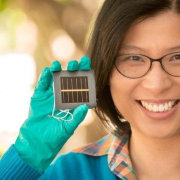Glass that insulates and generates energy? It's not far away ...
Could this be the future of solar? Dr Anita Ho-Baillie has been working hard on a type of cell that can be inserted into glass
It’s easy to think that the solar industry is just ‘ticking along’, but technology is actually progressing in leaps and bounds. One type of solar technology in particular, involving perovskites, is especially exciting. Perovskite 101 To start, it’s important understand exactly what perovskite solar cells actually are. Perovskite itself is a mineral that’s extremely efficient at absorbing light and transporting charges – useful qualities for solar. These cells are also cheap to produce. Instead of the 800 degree baking process that’s required for silicon cells, perovskites are made at low temperatures. This isn’t to mention the fact that they’re 200 times thinner than silicon cells. Development in the space has been progressing for years, with cell efficiency and durability continuing to climb, year after year. Moving forward Senior Research Fellow at the Australian Centre for Advanced Photovoltaics and University of New South Wales researcher Dr. Anita Ho-Baillie announced that her team had achieved the highest efficiency rating yet with the largest perovskite cells. Her team managed a 12.1 per cent efficiency rating with a 16 cm² solar cell. It’s a promising development, especially given the increasing global focus on solar power. “This is a very hot area of research, with many teams competing to advance photovoltaic design,” Dr. Ho-Baillie explained. “Perovskites came out of nowhere in 2009, with an efficiency rating of 3.8%, and have since grown in leaps and bounds. These results place UNSW amongst the best groups in the world producing state-of-the-art high performance perovskite solar cells. And I think we can get to 24% within a year or so.” However, there is one rather glaring issue with perovskite solar cells – they’re not extremely durable. Without proper protections, they’ll last just a few months thanks to water damage and temperature changes. Dr. Ho-Baillie and her team are working hard to improve durability. “Nevertheless, there are many existing applications where even disposable low-cost, high-efficiency solar cells could be attractive,” says Ho-Baillie. “Such as use in device charging and lighting in electricity-poor regions of the world.” The perfect use-case? Just recently, it was announced that Dr. Ho-Baillie would be working with University of Sydney’s Professor David McKenzie and Viridian Glass on a new project to integrate semi-transparent perovskite solar cells with a double-glazed vacuum-insulated window unit. See where this is going? In the future, skyscrapers and house windows could have solar cells integrated directly into the glass– meaning energy generation without sacrificing natural light. Coupled with rooftop solar, it’s not hard to imagine buildings becoming mini-power plants. This use for perovskite also solves the durability issue. Instead of leaving the vulnerable cells exposed, a glass sandwich will keep them protected. You can read read more on about this exciting new solar technology on the University of New South Wales website Sources www.thefifthestate.com.au www.engineering.unsw.edu.au https://www.nature.com/news/make-perovskite-solar-cells-stable-1.21807
Story by: Trends
Home kitchen bathroom commercial design



